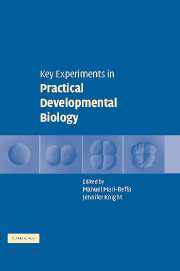Book contents
- Frontmatter
- Contents
- List of contributors
- Preface
- Introduction
- SECTION I GRAFTINGS
- SECTION II SPECIFIC CHEMICAL REAGENTS
- SECTION III BEAD IMPLANTATION
- SECTION IV NUCLEIC ACID INJECTIONS
- SECTION V GENETIC ANALYSIS
- SECTION VI CLONAL ANALYSIS
- 14 The role of the gene apterous in the development of the Drosophila wing
- 15 Extramacrochaetae, an example of a gene required for control of limb size and cell differentiation during wing morphogenesis in Drosophila
- 16 Hedgehog transduction pathway is involved in pattern formation in Drosophila melanogaster tergites
- SECTION VII IN SITU HYBRIDIZATION
- SECTION VIII TRANSGENIC ORGANISMS
- SECTION IX VERTEBRATE CLONING
- SECTION X CELL CULTURE
- SECTION XI EVO–DEVO STUDIES
- SECTION XII COMPUTATIONAL MODELLING
- Appendix 1 Abbreviations
- Appendix 2 Suppliers
- Index
- Plate Section
- References
16 - Hedgehog transduction pathway is involved in pattern formation in Drosophila melanogaster tergites
Published online by Cambridge University Press: 11 August 2009
- Frontmatter
- Contents
- List of contributors
- Preface
- Introduction
- SECTION I GRAFTINGS
- SECTION II SPECIFIC CHEMICAL REAGENTS
- SECTION III BEAD IMPLANTATION
- SECTION IV NUCLEIC ACID INJECTIONS
- SECTION V GENETIC ANALYSIS
- SECTION VI CLONAL ANALYSIS
- 14 The role of the gene apterous in the development of the Drosophila wing
- 15 Extramacrochaetae, an example of a gene required for control of limb size and cell differentiation during wing morphogenesis in Drosophila
- 16 Hedgehog transduction pathway is involved in pattern formation in Drosophila melanogaster tergites
- SECTION VII IN SITU HYBRIDIZATION
- SECTION VIII TRANSGENIC ORGANISMS
- SECTION IX VERTEBRATE CLONING
- SECTION X CELL CULTURE
- SECTION XI EVO–DEVO STUDIES
- SECTION XII COMPUTATIONAL MODELLING
- Appendix 1 Abbreviations
- Appendix 2 Suppliers
- Index
- Plate Section
- References
Summary
OBJECTIVE OF THE EXPERIMENT Lewis Wolpert originally proposed that a gradient of a diffusible molecule could control pattern formation depending on its concentration (Wolpert, 1969). Hedgehog (Hh) is one such widely accepted morphogenetic signal. In this exercise, we will study the function of the Hh transduction pathway in the control of pattern formation during the development of tergites (the dorsal cuticle of each abdominal segment) of Drosophila melanogaster.
DEGREE OF DIFFICULTY Moderate. The experiments described are relatively easy, inexpensive and can be carried out quickly.
INTRODUCTION
Pattern formation is one of the fundamental topics in Developmental Biology. Lewis Wolpert proposed a theoretical explanation of this process in his positional information model (Wolpert, 1969). Although a previous related model was also published (von Ubisch, 1953), the positional information model has been widely applied to a variety of developing systems. On the basis of previous results from hydra (Chapter 1) and insect segments (Locke, 1959; Lawrence, 1966; Stumpf, 1966; 1968), Wolpert (1969) suggested the existence of a gradient of a diffusible substance. This diffusible substance would be differentially interpreted into positional values. Depending on its position and how each cell interpreted the concentration of the substance, a variety of cell types could then differentiate. In order to explain his model better, Wolpert (1969) proposed the French flag model (Figure 16.1). The different colours in a cellular flag would appear as the differential expression of genes induced by the concentration of a diffusible molecule, or morphogen, distributed in a gradient away from a source or organiser (Figure 16.1).
- Type
- Chapter
- Information
- Key Experiments in Practical Developmental Biology , pp. 190 - 204Publisher: Cambridge University PressPrint publication year: 2005
References
- 1
- Cited by

